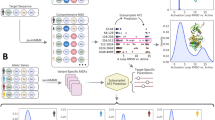Abstract
Small particles have a lower melting point than bulk material1. The physical cause lies in the fact that small particles have a higher proportion of surface atoms than larger particles—surface atoms have fewer nearest neighbours and are thus more weakly bound and less constrained in their thermal motion2,3 than atoms in the body of a material. The reduction in the melting point has been studied extensively for small particles or clusters on supporting surfaces. One typically observes a linear reduction of the melting point as a function of the inverse cluster radius2,4,5. Recently, the melting point of a very small cluster, containing exactly 139 atoms, has been measured in a vacuum using a technique in which the cluster acts as its own nanometre-scale calorimeter6,7. Here we use the same technique to study ionized sodium clusters containing 70 to 200 atoms. The melting points of these clusters are on average 33% (120 K) lower than the bulk material; furthermore, we observe surprisingly large variations in the melting point (of ±30 K) with changing cluster size, rather than any gradual trend. These variations cannot yet be fully explained theoretically.
This is a preview of subscription content, access via your institution
Access options
Subscribe to this journal
Receive 51 print issues and online access
$199.00 per year
only $3.90 per issue
Buy this article
- Purchase on Springer Link
- Instant access to full article PDF
Prices may be subject to local taxes which are calculated during checkout



Similar content being viewed by others
References
Pawlow, P. Über die Abhängigkeit des Schmelzpunktes von der Oberflächenenergie eines festen Körpers. Z. Phys. Chem. 65, 1–35 (1909).
Couchman, R. R. The Lindemann hypothesis and the size dependence of melting temperatures II. Phil. Mag. A 40, 637–643 (1979).
Berry, R. S. When the melting and freezing point are not the same. Sci. Am. 263, 50–56 August ((1990)).
Buffat, Ph. & Borel, J. P. Size effect on the melting temperature of gold clusters. Phys. Rev. A 13, 2287–2298 (1976).
Lai, S. L., Guo, J. Y., Petrova, V., Ramanath, G. & Allen, L. H. Size-dependent melting properties of small tin particles: nonocalorimetric measurements. Phys. Rev. Lett. 77, 99–102 (1996).
Schmidt, M., Kusche, R., Kronmüller, W., v. Issendorff, B. & Haberland, H. Experimental determination of the melting point and heat capacity for a free cluster of 139 sodium atoms. Phys. Rev. Lett. 79, 99–102 (1997).
Bertsch, G. Melting in clusters. Science 277, 1619 (1997).
Hovick, J. W. & Bartell, L. S. Phase and phase-changes in tert-butyl thiol. J. Mol. Struct. 413, 615–620 (1997).
Martin, T. P. Shells of atoms. Phys. Rep. 273, 199–241 (1996).
Buck, U. & Ettischer, I. Experimental evidence for an isomeric transition of size selected methanol hexamers. J. Chem. Phys. 100, 6974–6976 (1994).
Ellert, Ch., Schmidt, M., Schmitt, Ch., Reiners, Th. & Haberland, H. Temperature dependence of the optical response of small, open shell sodium clusters. Phys. Rev. Lett. 75, 1731–1734 (1995).
Wales, D. J. & Berry, R. S. Freezing, melting, spinodals, and clusters. J. Chem. Phys. 92, 4473–4481 (1990).
de Heer, W. A. The physics of simple metal clusters: experimental aspects and simple models. Rev. Mod. Phys. 65, 611–676 (1993).
Brack, M. The physics of simple metal clusters: self-consistent jellium model and semi-classical approaches. Rev. Mod. Phys. 65, 677–732 (1993).
Cleveland, C. L. et al. Structural evolution of smaller gold nanocrystals: the truncated decahedral motif. Phys. Rev. Lett. 79, 1873–1876 (1997).
Acknowledgements
This work was supported by the Deutsche Forschungsgemeinschaft.
Author information
Authors and Affiliations
Corresponding author
Rights and permissions
About this article
Cite this article
Schmidt, M., Kusche, R., von Issendorff, B. et al. Irregular variations in the melting point of size-selected atomic clusters. Nature 393, 238–240 (1998). https://doi.org/10.1038/30415
Received:
Accepted:
Issue Date:
DOI: https://doi.org/10.1038/30415
This article is cited by
-
Towards an Improved Understanding of the Evolution of the Size Distribution of Ultrafine Nanoparticles Produced by a Rapidly Quenched Vapor Source
Metallurgical and Materials Transactions A (2024)
-
Core atoms escape from the shell: reverse segregation of Pb–Al core–shell nanoclusters via nanoscale melting
Discover Nano (2023)
-
Scalable synthesis of Cu clusters for remarkable selectivity control of intermediates in consecutive hydrogenation
Nature Communications (2023)
-
Dynamics and thermodynamics of core/shell formation of icosahedral NimAgn bimetallic nanostructures
Journal of Materials Science (2021)
-
Synthetic strategies of supported atomic clusters for heterogeneous catalysis
Nature Communications (2020)
Comments
By submitting a comment you agree to abide by our Terms and Community Guidelines. If you find something abusive or that does not comply with our terms or guidelines please flag it as inappropriate.



